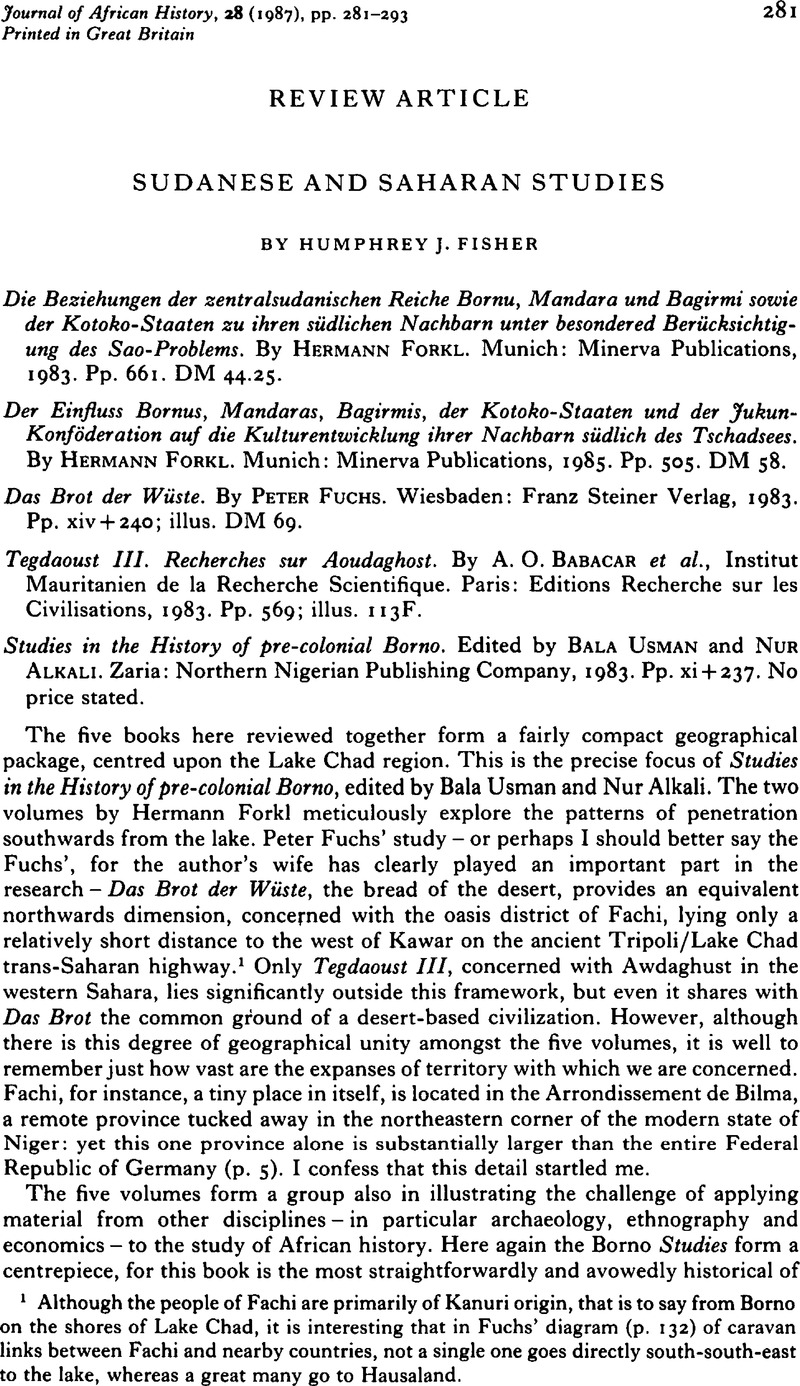Article contents
Sudanese and Saharan Studies
Published online by Cambridge University Press: 22 January 2009
Abstract

- Type
- Review Articles
- Information
- Copyright
- Copyright © Cambridge University Press 1987
References
1 Although the people of Fachi are primarily of Kanuri origin, that is to say from Borno on the shores of Lake Chad, it is interesting that in Fuchs' diagram (p. 132) of caravan links between Fachi and nearby countries, not a single one goes directly south-south-east to the lake, whereas a great many go to Hausaland.Google Scholar
2 al-Hajj, Muhammad, in Studies, is of this school: we learn from Ibn Fartua, he claims, that the ‘many Turkish musketeers’ in Alooma's army ‘decided the issue of the most serious battles’, and were ‘decisive’ in the capture of Amsaka (p. 161). Sa'ad Abubakar concurs: because of firearms and Turkish musketeers, Alooma achieved ‘remarkable military victories where his predecessors had failed’ (Studies, p. 223).Google Scholar
3 Fartua, Ahmed Ibn, History of the First Twelve Years of the Reign of Mai Idris Alooma of Bornu (1571–1583), ed. and trans. Palmer, H. R. (Lagos, 1926, reprinted London, 1970), 12.Google Scholar
4 Ibid., 25–9.
5 ‘The central Sahara and Sudan’, in the Cambridge History of Africa, IV: C. 1600 – c. 1790, ed. Gray, Richard (Cambridge, 1975), 71.CrossRefGoogle Scholar
6 Nachtigal, G., Sahara and Sudan, III: The Chad Basin and Bagirmi (London, 1986), 340.Google Scholar
7 Ibid., 343–4.
8 Fartua, Ibn, History, 11.Google Scholar
9 Nachtigal, The Chad Basin, 352ff.Google Scholar
10 Virginia Rowland and I have argued along these lines in an earlier paper in this Journal, ‘Firearms in the central Sudan’, XII, 2 (1971), 215–39.Google Scholar
11 pp. 39–40. Isolated kidnapping, by the Tubu, for enslavement in Tibesti, occurred at least as late as 1972 (p. 53). For the fact that in Bilma relatively fewer palms had been planted before the colonial period, Nachtigal is cited, a passage however which simply says that datepalms were not abundant in the immediate vicinity of the principal Bilma town (vol. II: Kawar, Bornu, Kanem, Borku, Ennedi (London, 1980), 53). One point about dates to which Nachtigal, a medical doctor, paid some attention, but Fuchs does not, is their lamentable effect upon teeth; but the detail in Fuchs (pp. 87–9) may be relevant, that a medicinal plant, mádama, used against swellings caused by bad teeth, occupies a greater garden area than, say, cabbage, gourds, watermelons, groundnuts, radishes, or various other crops.Google Scholar
12 The term kárama, witch or wizard, appears in S. W. Koelle's African Native Literature (1854, reprinted 1968), 311; it would be interesting to know whether the term is linked in any way with the Arabic karamah, which may mean miracle or blessing. Koelle gives káram as alligator, crocodile.Google Scholar
13 The variety of items which may serve as sadaka is considerable: Tuareg caravaneers, coming to Fachi for the first time, place in an appointed spot a stone, as sadaka, in order to win the friendly disposition of the local spirits; caravans going west from Fachi scatter dates as sadaka about a kilometer from town children follow the caravans, gather the dates, and gobble them up (p. 178).Google Scholar
14 Studies, pp. 167–8.Google Scholar
15 The tendency to overestimate the practical impact of theoretical legal models appears also in the suggestion that, as some non-Muslim subjects of Borno paid taxes in clothing, this ‘…must have been based on the Islamic precedence [sic] whereby the Christians of Najran… had been privilege [sic] by the Caliph 'Umar to pay… in garments instead of cash’ (p. 95). Maybe: but in many parts of Borno, and of adjacent districts, garments circulated practically as a form of currency, occasionally almost as the form of currency, and it seems unnecessary to go back to Najran to explain this.Google Scholar
16 Vol. II, pp. 160, 193; Nachtigal does not give any specific name for such a tax, but he does mention that the jengal, a tax in cattle, was levied on nomads in Bagirmi (vol. III, p. 379).Google Scholar
17 For example, on p. 116 the same paragraph appears in what I take to be both revised and unrevised form, and pp. 123 and 124 are reversed.Google Scholar
18 Such reasonable excuses do not, of course, apply to western English-speaking Africanists, who almost equally chary of their German Nachtigal citations.Google Scholar
- 1
- Cited by


